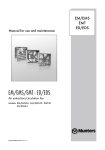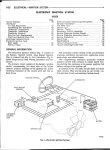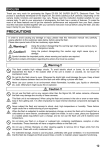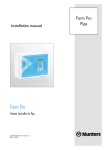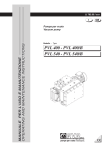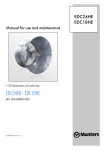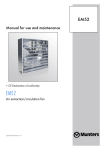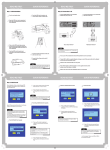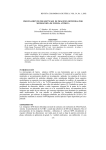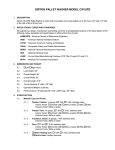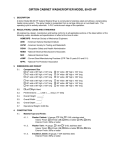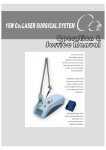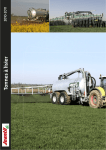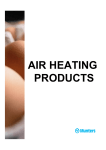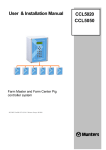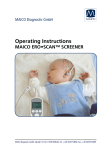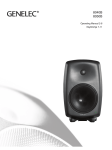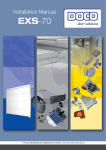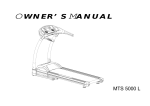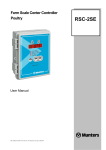Download ED/EDS/EDT HE
Transcript
Manual for use and maintenance + CE Declaration of conformity ED/EDS/EDT HE Air extraction/circulation fan Models: ED/EDS36HE - ED/EDS30HE ED/EDS24HE - EDT30HE Ag/MIT/UmGB-2145-10/13 rev 1.0 EDHE EDSHE EDTHE ED/EDS/EDT HE Manual for use and maintenance Original instructions This manual for use and maintenance is an integral part of the apparatus together with the attached technical documentation and has been produced with reference to Directive 2006/42/EC, paragraph A, Annex II, and to ErP Directive 2009/125/CE Commission Regulation 327/2011. This document is destined for the user of the apparatus: it may not be reproduced in whole or in part, committed to computer memory as a file or delivered to third parties without the prior authorisation of the assembler of the system. Munters Italy S.p.A. reserves the right to effect modifications to the apparatus in accordance with technical and legal developments. 2 © Munters AB, 2013 Index chapter 1. 2. 3. 4. 5. 6. page CE DECLARATION 5 1.1 1.2 1.3 1.4 1.5 6 6 6 6 7 Disclaimer Introduction Notes Data for Fan Ecodesign Directive Attached technical documentation SAFETY ASPECTS 8 2.1 Personnel requirements 2.2 General safety instructions 2.3 Safety devices 2.4 Residual risks 8 9 9 11 BEFORE USING 13 3.1 Delivery check 3.2 Packaging and transport of assembled fans 3.3 Structure 13 13 13 OPERATING CONDITIONS 14 4.1 Intended conditions of use 4.2 Non-permitted conditions of use 14 14 INSTALLATION 17 5.1 Choice of site and checking installation requirements 5.2 Installing Series EM fans 5.3 Installing Series EMS fans 5.4 Connection to the electrical system 5.5 Tests and checks before startup 17 18 19 19 22 COMMISSIONING 23 6.1 Control devices 6.2 Instructions for machine use 23 23 © Munters AB, 2013 3 Index 7. 4 TECHNICAL DATA 25 7.1 Dimensions 7.2 Technical specifications 7.3 Motor specifications 25 26 27 8. MAINTENANCE 8.1 Introduction 8.2 Cleaning 8.3 Replacement of propeller 8.4 Replacement of shutter bearing assembly 8.5 Fan bearing lubrication 8.6 Replacement of shutter opening device (centrifugal system) 28 9. SPARE PART LIST 32 10. WARRANTY 56 © Munters AB, 2013 28 28 29 30 31 31 CE Declaration 1. CE DECLARATION OF CONFORMITY (complies with Subparagraph A Annex II Directive 2006/42/EC) Munters Italy S.p.A. with registered offices in Strada Piani 2 – 18027 Chiusavecchia (IM) – Italy DECLARES ON ITS OWN RESPONSIBILITY THAT THE APPARATUS Designation Model Year of manufacture Fan designed for moving air to control temperature and humidity in greenhouses or rearing sheds. ED/EDS36HE - ED/EDS30HE - ED/EDS24HE - EDT30 2013 conforms with the essentiAl safety requirements stated by Apparatus Directive 2006/42/EC and performance requirements comply with the eRp directive 2009/125/ce. With particular reference to the following provisions: UNI EN 953:2009, UNI EN ISO 12100:2010, UNI EN ISO 12499:2009, UNI EN ISO 13857:2008, CEI EN 60204-1:2006 (CEI 44-5), uni EN iso 5801:2009 Chiusavecchia, 25th September 2013 Marco Scomparin Legal representative © Munters AB, 2013 5 Chapter1 CE Declaration 1.1 Disclaimer Munters reserves the right to make alternations to specifications, quantities, dimensions etc. for production or other reasons, subsequent to publication. The information contained herein has been prepared by qualified experts within Munters. While we believe the information is accurate and complete, we make no warranty or representation for any particular purposes. The information is offered in good faith and with the understanding that any use of the units or accessories in breach of the directions and warnings in this document is at the sole discretion and risk of the user. 1.2 Introduction Congratulations on your excellent choice of purchasing an Euroemme® fan! In order to realize the full benefit from this product it is important that it is installed, commissioned and operated correctly. Before installation or using the fan, this manual should be studied carefully. It is also recommended that it is kept safely for future reference. The manual is intended as a reference for installation, commissioning and dayto-day operation of the Euroemme fans. 1.3 Notes Date of release: 2013. Munters cannot guarantee to inform users about the changes or to distribute new manuals to them. All rights reserved. No part of this manual may be reproduced in any manner whatsoever without the expressed written permission of Munters. The contents of this manual are subject to change without notice. 1.4 Data for Fan Eco Design Directive Product information requirements* → Specific ratio 8 RPM at optimum energy efficiency 7 Pressure at optimum energy efficiency [Pa] 6c Flow rate at optimum energy efficiency [m3/h] 6b Motor power input at optimum energy efficiency [W] 6a VSD must be installed with the fan 5 Target efficiency grade 2013 (2015) optional Efficiency grade 4 Efficiency category 3 Measurement category 2 ED36HE 0.75hp 3ph 50Hz OS 34,6 A static 41,4 36 (40) no 834 13.140 78,9 898 1 ED36HE 0.75hp 3ph 50Hz MS 32,7 A static 39,3 36 (--) no 900 12.783 82,8 882 1 ED36HE 0.75hp 1ph 50Hz MS 31,0 A static 37,7 36 (--) no 888 10.970 90,4 907 1 ED30HE 0.50hp 3ph 50Hz OS 34 A static 41,8 36 (40) no 588 9.149 78,8 846 1 ED30HE 0.50hp 3ph 50Hz MS 32,6 A static 40,3 36 (40) no 604 8.989 78,7 887 1 ED30HE 0.50hp 1ph 50Hz MS 30,2 A static 38,2 36 (--) no 557 7.713 78,7 904 1 ED24HE 0.50hp 3ph 50Hz OS 32,4 A static 40,2 36 (40) no 590 6.300 109,5 1.289 Fan description* 6 1 Overall efficiency η% (according to ANNEX I - 3.2 of regulation) © Munters AB, 2013 1 Chapter1 CE Declaration ED24HE 0.50hp 3ph 50Hz MS 33 A static 41 36 (40) no 539 5.845 109,5 1.320 1 ED24HE 0.50hp 1ph 50Hz MS 29,3 A static 37,3 36 (--) no 545 5.294 108,6 1.320 1 1.5 Attached technical documentation The listed documentation is to be considered an integral part of this manual: • technical sheet/electric motor instruction booklet. © Munters AB, 2013 7 Safety aspects Warning 2. Failure to respect safety or behavioural rules can produce hazardous situations for users as well as damage to the machine and the place where it is installed. The fan must only be used if it is in perfect operating condition, by personnel who are perfectly aware of the safety measures and possible hazards, and in strict compliance with the instructions given in this manual. 2.1 Personnel requirements Equipment may only be used by personnel who know and apply the specific requirements given in the user and maintenance manual and the more general instructions contained in various regulations for accident prevention and applicable legislation regarding safety in the workplace, as well as other European Community directives incorporated by the member states into their national legislation. Knowledge and understanding of the manual and of the attached documents constitute an indispensable tool for reducing hazards and promoting the safety and health of workers. Personnel training All operators engaged in the use of the fan must have received adequate information from the employer relating to: • risks to health and safety at work connected with the use of the machine; • first aid procedures, fire precautions and evacuation of workplaces; • devices provided for the safety of operators, and residual risks generated by the machine. In particular, the employer has the following duties: • when assigning tasks to operators, to take into account their capabilities in the interests of safeguarding their health and safety; • to provide adequate means of protection; • to require compliance by individual operators with the company rules and provisions regarding safety and the use of the collective and individual protective measures at their disposal; • to ensure that normal and special maintenance operations, or in any event operations necessary for machine safety, are regularly carried out. All operators must take care of their own safety and health as well as that of other people in the workplace who may be affected by their actions or omissions, in accordance with their personal skills, and the instructions and means provided to them by the employer. Warning 8 Unauthorized tampering/replacement of one or more parts of the machine, or the use of accessories, tools or materials other than those recommended by the manufacturer, are prohibited and release the manufacturer from all liability. © Munters AB, 2013 Chapter2 Safety aspects Warning Operators must be trained to deal with the occurrence of possible faults, malfunctions or dangerous conditions to themselves or others, and in such an event must: • stop the fan immediately by operating the emergency stop device (mushroomshaped pushbutton/main switch mounted on the electrical panel); • not carry out operations which are beyond their duties and/or technical knowledge. 2.2 General safety instructions Warning • Safety devices must not be removed or rendered ineffective; • the fan must not be started with guards removed; • any adjustment or maintenance operation must be performed with the electrical isolating device activated and locked in position with a padlock; • any operation is prohibited which may cause arcing or sparks or other situations which could start a fire; • in the event of alarm signals resulting in the intervention of safety devices, the operator must ask for immediate action by qualified technicians responsible for maintenance; • user must ensure that the environmental and electricity supply conditions in which the fan operates are always within the limits specified in this user manual; • do not for any reason modify parts of the fan in order to fit additional devices. 2.3 Safety devices In the process of designing and building the fan, the manufacturer adopted the necessary technical solutions to ensure compliance with fundamental safety requirements: the object of the risk reduction process was to ensure that the operator can use the fan in safety. The machine is provided with protection devices of fixed type and is fitted with an actuator for the emergency stop function. Fixed guards The fixed guards are solidly fixed to the structure of the machine and cannot easily be eluded: the guards are fixed with systems which require the use of tools for dismantling. Warning Do not start the fan with fixed guards removed: the guards can only be removed with special tools, by specialized and trained personnel and with the system stationary (emergency system activated and electricity and hydraulic fluid isolated). At the end of maintenance operations, the guards which were removed must be replaced correctly. © Munters AB, 2013 9 Chapter2 Safety aspects Position of guard Outlet side of fan Type of guard Notes Guard of fixed type made of metal mesh. Dimensions and positioning in accordance with the instructions in the standard UNI EN 13857. Removable only by means of special tool. Guard of fixed type made of metal mesh. Dimensions and positioning in accordance with the instructions in the standard UNI EN 13857. Removable only by means of special tool fig. 1 Intake side of fan fig. 2 10 © Munters AB, 2013 Chapter2 Safety aspects Emergency stop function The machine must be equipped at the installation stage with an electrical panel, on which must be installed an actuator for the emergency stop function, which when operated brings dangerous movements to a halt by isolation of the power supply: the button must be mushroom-shaped and coloured red, provided with mechanical restraint and released by turning. fig. 3 2.4 Residual risks Mechanical hazards Part of machine/stage of use Description Plates/provisions/PPE Hazard arising from failure to observe ergonomic principles, caused by excessive strain, i.e. generic mechanical hazard during the moving and installing stages of the machine. Installation of machine fig. 4 Electrical hazards System area Description Panels, covers and electrical apparatus. The safety signs must be fixed in an extremely visible position on the door of the electrical panel and on covers containing electrical apparatus, to highlight the risks to which an operator could be exposed in the event of opening the electrical panel (danger resulting from the presence of live parts), the level of voltage present, the prohibition of tampering by unauthorized personnel and the prohibition on the use of liquids on electrical apparatus in the event of fire. © Munters AB, 2013 Plates/provisions/PPE fig. 5 11 Chapter2 Safety aspects Hazards generated by noise Fan model Max sound pressure level Lp [dB(A)] ED/EDS36HE - 0.75hp 81.7 ED/EDS30/EDT30HE - 0.50hp 79.1 ED/EDS24HE - 0.50hp 80.5 A measurement has been made of the noise produced by the machine during normal operation in order to calculate the equivalent level in conditions of normal use. These values are shown in the above table. The measurement has been taken according to the UNI EN ISO 11202:2010. 12 Warning The user and the employer must comply with current national law in terms of protection against daily personal exposure of operators to noise, by providing the use of personal protective equipment (earmuffs, earplugs, etc.) if necessary, depending on the overall level of sound pressure in the installation area, and the daily personal exposure of the employees. In areas where the overall sound level reaches excessive values, personal protective equipment must be used. Warning The fan must only be used if it is in perfect operating condition, by personnel, aged more than 14 years who are perfectly aware of the safety measures and possible hazards, and in strict compliance with the instructions given in this manual. © Munters AB, 2013 Before using 3. 3.1 Delivery check Upon receipt, inspect the fan for external damage and if found, inform the forwarding agent without delay. Check the data on all the rating plates, especially voltage and frequency. Turn propeller by hand to check free rotation. Check the opening of the shutter by hand. 3.2 Packaging and transport of assembled fans The fan has a self-supporting structure in galvanised steel and it is usually delivered without packaging. Upon request fans can be delivered packed in cardboard boxes. Fans should not be permanently stocked one upon the other, regardless if they are delivered with or without packaging. Handling of the fans should not be done manually as the fans have no handles or grips. Consequently one of the following alternatives should be used: • trolley: when loading the fan on the trolley make sure fan shutter is positioned outwards; • forklift: before loading, make sure the forks are opened as much as possible to avoid bending of the fan bottom panel and damaging the shutter; • crane: fix two bolts in the M8 bushes situated on the sides of the fan housing and hook the lifting cable over the bolts Warning Make sure a steel cable or rope of adequate size is being used when the fan is lifted by crane. Fan weights are shown in the technical specification table (see section 7.1). 3.3 Structure The fans consist of the following components: • fan housing in galvanised steel without welding spots; • fan shutter in galvanised steel, which pivots on UV protected plastic bushes and pins; • propeller with three blades* in stainless, precoated or galvanised steel; blades are fixed to the propeller by high-strength pop rivets; • asynchronous three-phases motor (single-phase upon request); 50 or 60 Hz; B3 form; F class winding insulation, IP55 protection class; single-speed or multi-speed; • centrifugal operated shutter opening device. * Number may vary according to fan model. © Munters AB, 2013 13 Operating conditions 4. 4.1 Intended conditions of use Fans, fanjets and circulators are machines designed for moving air to control temperature and humidity in greenhouses or rearing sheds by extraction or internal recirculation, not for being operated in positive pressure environments. They can even be installed horizontally, without altering or modifying their characteristics. fig. 6 The fan has been designed and built to operate in safety for the user, if used according to the conditions intended by the manufacturer and stated in this user and maintenance manual. ! note For further information, please refer to the technical documentation attached to this manual. 4.2 Non-permitted conditions of use Total or partial failure to observe the instructions given in this manual could cause damage to the fan and/or people. The following uses are to be considered not permitted and improper: • use in the event of faults and/or tampering with the installed safety devices; • use by personnel not specifically trained; • installation of the fan operating in positive pressure environments; • use contrary to existing regulations; • incorrect installation differing from instructions given in this manual; 14 © Munters AB, 2013 Chapter4 Operating conditions • • • • • supply from an electrical network with characteristics different from that specified in the wiring diagram; total or partial failure to observe instructions; insufficient maintenance; use of non-original spare parts; use of lubricants with characteristics different from those specified in the technical documentation attached to the manual; • use by minors; • use under the influence of drugs, alcohol, etc. Warning Use of the fan other than as described in the user manual or outside the operational limits laid down by the manufacturer is considered IMPROPER USE. In the event of IMPROPER USE the manufacturer declines all liability in relation to any damage that may be caused to persons or property, and any kind of warranty will be considered invalidated. Use of non-original spare parts Original spare parts ensure the reliability and safety of the operation of the fan: in the event of maintenance/ replacement, consult the spare parts list, the list of parts and components used and the relevant technical documentation attached to this manual. Warning In the event of replacement of safety devices, it is essential to maintain the safety and operational characteristics of the original device, preferring replacement with an identical component. Insufficient maintenance A correct normal maintenance is one that maintains the original integrity or restores the fan’s efficiency, while at the same time limiting normal deterioration resulting from use. Special maintenance work can also prolong the usable life of the machine and/or, secondarily, can improve its efficiency, reliability, productivity and ease of maintenance and inspection. Unauthorized modifications or tampering No operation is permitted which is aimed at making modifications to the fan and the safety devices fitted to it; similarly, it is not possible to alter its operational and performance characteristics. Warning Interference with the command and control circuits is prohibited: such operations could cause damage to the equipment and serious danger to the operator. © Munters AB, 2013 15 Chapter4 Operating conditions ! note Modifications made to the fan which do not come into the categories of normal and special maintenance, or which alter its operational and performance characteristics, invalidate the machine’s compliance with the requirements of the applicable directives, as attested by the manufacturer with the EC declaration of conformity: it is up to the person responsible for the modification to resubmit the machine to the assessment conformity procedures specified in the applicable directives. Use in a potentially explosive atmosphere The fan has been designed and built to operate in environments where the presence of a potentially explosive atmosphere is not expected, in other words it is not intended to handle materials which release explosive dust. Emission into the atmosphere of harmful particles or gases must be contained within the limits established by current regulations. Warning 16 The fan has been designed and built in such a way that it CANNOT operate in a classified area, according to directive 1999/92/EC. © Munters AB, 2013 Installation 5. After fan has been delivered but before fitting and installation, check condition of the consignment: in the event of discrepancy or damage to the machine, the manufacturer or carrier must be informed immediately. Warning Fitting and installation of the fan must be performed by specialized personnel, in order to prevent damage to the equipment or hazards to people as a result of faulty fitting. Fitting the fan must be carried out according to the following stages: • positioning and anchoring the fan; • connection to the mains electricity supply; • operational testing and putting into operation. 5.1 Choice of site and checking installation requirements The user is responsible for preparing an area suitable for installation of the equipment and complying with the requirements laid down by European directives and national law governing safety at places of work. Environmental conditions for operating the equipment are as follows: Ambient temperature during operation Ambient humidity during operation - 25°C / + 50 °C < 90% For operation of fan installation, a manoeuvring area must be made available that is suitable for the fan dimensions and the chosen lifting equipment: electrical points must be provided in the installation area for fan connection to the mains electricity supply. Warning The fans must be installed at a height of not less than 2.7 m from the ground. If they are installed at a lower height, the fans must be fitted with the optional pyramidal safety mesh by the manufacturer, to protect the internal rotor. Failure to install the safety mesh releases the manufacturer from all liability and shall be considered an improper use of the machine. Irrespective of the place of installation, suitable indelible warning signs are attached to the fan, warning of danger and giving instructions to remain at a safe distance not to place hands inside the shutter and not to run in proximity of the fan. The warning signs are yellow, self-adhesive and indelible. They are fitted to the front and rear of the fan, and marked with the numbers A-1997 and B-1997 (see fig.4). The area adjacent to the fan in the premises from which air is being extracted must be kept clear to allow the air to exit freely. It is also prohibited for anyone to remain in this area, because of the presence of organic gases and dust which may be present in the airflow. © Munters AB, 2013 17 Chapter5 Installation A-1997 B-1197 fig. 7 fig. 8 Warning The fans must be installed to carry out extraction or an internal circulation of the air present in the area, and must not operate in positive pressure environments. It is also permissible to install the fan in a horizontal position. 5.2 Installing Series ED fans If the fan is fixed directly to a metal structure, M8 bolts type 8.8 must be used, screwing them into the threaded inserts provided for the purpose on the bodywork (two per side). fig. 9 fig. 10 18 If the fan is installed in a masonry structure, an iron outer frame must be constructed (not supplied with the fan), with a 60 mm L-shaped profile at least 5 mm thick, with suitably-sized clamps. When the outer frame is properly built-in, i.e. perfectly level and upright, insert the fan, screwing four M8 bolts type 8.8 (not supplied with the fan) into the threaded inserts provided on the sides of the bodywork, two per side. © Munters AB, 2013 Chapter5 Installation 5.3 Installing Series ED fans The fan has to be fixed by means of M8 eyebolts type 8.8, screwing them into the threaded inserts provided for the purpose on the bodywork (two per side). fig. 11 - EDS36 model fig. 12 - EDS24/30 models Warning Always check up if cable and chain dimensions are suitable to hold up the fan’s weight and if they have the proper lenght to distribute the strain uniformly. Dimensioning must include also the thrust generated by airflow. 5.4 Connection to the electrical system The fan is supplied without a command and control circuit, but with all the internal electrical connections already made. At the fitting stage, the installer must set up a control panel in compliance with the requirements of standard IEC EN 60439-1, and arrange the wiring of the fan in accordance with the instructions in standards IEC EN 60204-1 and IEC 60364. The electrical panel of the fan must generally be equipped with the following devices (bearing EC marking as per directive 2006/95/EC): Lockable isolating switch. fig. 13 fig. 14 Magnetothermic switch (chosen to suit the power of the motor). The need to fit a switch of differential type depends on the configuration of the electrical system supplying the fan: it is the installer’s responsibility to make this assessment in accordance with the instructions in standard IEC 60364. © Munters AB, 2013 19 Chapter5 Installation Red emergency stop button, mushroom type, provided with mechanical locking and release by turning (in compliance with UNI EN ISO 13850). Operating the button must bring about the electromechanical isolation of the power supply to the electric motor (category 0/1 according to IEC EN 60204-1). fig. 15 Start/stop selector switch (with characteristics compatible with the nominal current of the motor), or main panel for managing the equipment, with control devices which act on the electrical supply to the fan. fig. 16 Warning Do not supply power to the fan during installation stage. Installer must issue a declaration of correct installation in accordance with applicable legislation in the country of use. Below are suggested wiring diagrams for connecting the fan to the mains electrical supply. These diagrams are however subject to local laws and regulations and should be modified if necessary to comply with such laws and regulations. 3 x 400V or 3 x 230V 2 1 3 2 + - 4 3 L1 M L2 L3 fig. 17a 1 x 230V 2 1 3 2 + - 4 3 M L N fig. 17b 1 = Overload protection switch 2 = Circuit breaker 3 = Fan motor 20 © Munters AB, 2013 Chapter5 Installation The rating plate data of the electric motor and the instructions given in the attached technical documentation must be used for sizing the power supply cable. Warning In the event of installations that do not comply with the directions given in this chapter, the manufacturer’s liability ceases, along with the validity of the CE Declaration of Conformity. The electrical lines must be laid in accordance with requirements of the laws applying in the place of installation, and in any event: • they must be laid with cables of adequate section for the power of the fan and the length of the line itself; • they must make an effective earth connection; • they must have isolating devices and automatic protection against overload and short circuits. Before activating the electrical supply to the machine by turning the isolator switch to position On, a series of checks must be made: • check that the voltage and frequency of the power source correspond to those indicated in the equipment technical data and electrical diagram; • check that the supply cables and the conductor providing external protection are correctly connected; • check that the connections in the control and power circuits are properly tight; • check that the intensity of the short-circuit expected at the connection terminals is compatible with the breaking power of the protection switch upstream of the electrical panel; • check that the protection devices (fuses, magnetothermic switches) are correctly sized, and that the phases are connected in the correct order: check that the fan rotates clockwise; look at the exhaust side of the fan and check rotation of propeller (see fig. 9). fig. 18 Equipotential protection circuit To create effective protection against the risk of electrocution, the outer protection conductor must be connected to terminal PE inside an electrical panel. For correct sizing of the protection conductors, see following requirements as indicated in standard IEC EN 60204-1: • phase conductor up to 16 mm2: section of the protection conductor equal to the section of the supply conductor; • phase conductor between 16 and 35 mm2: section of protection conductor equal to 16 mm2; • phase conductor over 35 mm2: section of protection conductor equal to at least half the section of the supply conductor. © Munters AB, 2013 21 Chapter5 Installation Warning When connecting all the metal masses to the earth system, check that there are no insulating elements between the various conductive masses (metal parts). The system must not be put into operation unless the equipotentiality of the masses and the connection to the earth system have previously been checked. Protection against contact voltages The choice of device to protect the electrical system must be made in such a way as to ensure the safe intervention of the main automatic switches and any differential devices linked to them. For an appropriate choice of the type of protection for the machine’s supply line, taking into account whether the distribution system is TT or TN, it is advisable to consult an electrical systems designer, in order to ensure compliance with the requirements of standard IEC 64-8 or the equivalent provisions in the country where the machine is being installed. 5.5 Tests and checks before startup Before startup, it is extremely important to carry out a very careful check of the fan, in order to prevent malfunctions and/or accidents. In particular, perform the following operations: 1. Equipotential protection circuit: • check the fan visually, verifying that there are no particular mechanical irregularities or foreign bodies inside the structure; • check that the protective structures (fixed guards made of metal mesh) are correctly positioned and fixed; • check that the emergency stop function actuator operates correctly. 2. Checking the electrical system: • check that the supply conductors are properly fixed to the terminals of the isolating switch; • check the connections of the conductors in the equipotential circuit; • check that the guards inside the electrical panel are correctly positioned and fixed; • check that the safety devices are receiving power and are active, and check their effectiveness. After this series of checks has been carried out, the fan is ready for its first startup. 22 © Munters AB, 2013 Commissioning Warning 6. The fan must not be used without first reading and understanding the user manual and becoming completely familiar with the controls. 6.1 Control devices This chapter gives instructions on the control devices with which the electrical control panel must be fitted, which shall be done at the installation stage. At the fitting stage, the installer must set up a control panel complying with the requirements of standard IEC EN 60439-1 and arrange the wiring of the fan in accordance with the instructions in standards IEC EN 60204-1 and IEC 60364. The electrical circuit of the fan must generally be fitted with the devices indicated in section 5.4. 6.2 Instructions for machine use Switching on and starting up Before starting the machine: • check that all the guards for the hazardous areas are in their correct positions; • check that all the electrical safety components are in place and check their effectiveness by activating them; • check the presence of the electricity supply. To start the fan, go through the following procedure: • turn the isolator switch to position On; • press the fan starter button. Normal stopping In the event of necessity the fan can be stopped by operating the relative control device (stop), which shall be installed on the electrical panel. Activating this control must cause the fan blade to stop rotating, but does not cause isolation of the power supply: the fan can be started again by pressing the start button. In the event that the fan does not need to be used for an extended period of time, the following stop procedure must be used: • operate the stop button • operate the emergency stop button; • open the main isolator switch (position “0”) on the electrical panel and attach a padlock to the actuator. © Munters AB, 2013 23 Chapter6 Commissioning Warning Interrupting the electricity supply, equivalent to isolating by the operator with the main switch, causes complete fan shutdown: restoring the electricity supply will not cause any movement in the machine. Emergency stop Operating the main emergency stop button causes the fan to stop moving. The function is controlled by a red mushroom type button on a yellow background, provided with mechanical locking and release by turning. Operating it causes the instantaneous interruption of the power supply to the electric motor which makes the rotor turn (uncontrolled shutdown category 0 according to IEC EN 60204-1). Resetting after stopping 1. Resetting after normal stopping After normal stopping the operating cycle must be reset by following the procedure described in section 6.1. 2. Resetting after emergency stop After an emergency stop, the operating cycle must be reset by following the procedure described below: • reset the actuator by which the emergency stop command was given (by turning the relative mushroom button); • for an exact reset sequence, refer to the instructions given in section 6.1. 24 © Munters AB, 2013 Technical data 7. 7.1 Dimensions ED36HE - ED30HE - ED24HE D C A E B F G H fig.19 Model A B C D E F G H I ED36HE 1,090 1,090 520 600 M8 600 245 280 - ED30HE 950 950 520 600 M8 600 175 360 - ED24HE 745 745 510 590 M8 475 135 330 - EDS36HE - EDS30HE - EDS24HE C A D D D C C E I E F F B F G E H EDS24-30HE fig.20 Model G G H H EDS36HE EDT30 A B C D E F G H I EDS36HE 1,090 1,090 440 520 M8 1,040 20 25 - EDS30HE 950 950 440 520 M8 600 175 290 - EDS24HE 745 745 380 460 M8 475 135 200 - EDT30HE 950 950 440 458 M8 600 175 290 20 © Munters AB, 2013 25 Chapter7 Technical data 7.2 Technical specifications ED36HE ED30HE ED24HE 0.75hp 0.5hp 0.5hp Number of propeller blades 3 3 3 Number of shutter blades 8 7 5 915 [36] 770 [30] 610 [24] 70 60 49 Model Propeller diameter mm [inch] Weight of fully equipped fan* [kg] Airflow at 0 Pa m3/h [cfm] 19,100 [11,300] 14,400 [8,460] 9,100 [5,360] Airflow at12 Pa m3/h [cfm] 18,200 [10,700] 13,700 [8,080] 8,800 [5,180] Airflow at 25 Pa m3/h [cfm] 17,200 [10,100] 12,900 [7,620] 8,400 [4,960] Airflow at 37 Pa m3/h [cfm] 16,200 [9,530] 12,100 [7,120] 8,100 [4,770] 30.3 [17.8] 22.1 [13.0] 17.3 [10.2] 50 [122] 50 [122] 50 [122] IP55 IP55 IP55 F F F EDS36HE EDS30/EDT30HE EDS24HE 0.75hp 0.5hp 0.5hp 3 3 3 915 [36] 770 [30] 610 [24] 60 44 33 19,100 [11,300] 14,00 [8,460] 9,100 [5,360] 30.3 [17.8] 22.1 [13.0] 17.3 [10.2] 50 [122] 50 [122] 50 [122] IP55 IP55 IP55 F F F Specific performance at 0 Pa m3/h /W [cfm /W] Max. operating temperature °C [°F] IEC protective class of electric motor Electric motor winding insulation grade Model Number of propeller blades Propeller diameter mm [inch] Weight of fully equipped fan* [kg] m3/h [cfm] Airflow at 0 Pa Specific performance at 0 Pa m3/h /W [cfm /W] Max. operating temperature °C [°F] IEC protective class of electric motor Electric motor winding insulation grade 26 © Munters AB, 2013 Chapter7 Technical data 7.3 Motor specifications Code Nominal Power [W] [Hp] Phases Speed Frequency [Hz] Voltage [V] Current [A] Rpm ED/EDS36HE a 550 0.75 1 single 50 200/230 4.9 890 b 550 0.75 1 multi 50 200/230 4.9 890 c 550 0.5 1 single 60 208/230 4.2 1,140 d 550 0.5 3 single 50 230/400 2.6/1.5 910 e 550 0.5 3 single 60 230/400 2.4/1.4 1,100 f 550 0.5 3 multi 50 230/400 4.0/2.3 880 ED/EDS/EDT30HE a 370 0.5 1 single 50 200/230 2.9 870 b 370 0.5 1 multi 50 200/230 2.9 870 c 550 0.75 1 single 60 208/230 4.2 1,140 d 370 0.5 3 single 50 230/400 2.2/1.3 910 e 370 0.5 3 single 60 230/400 2.1/1.2 1,100 f 370 0.5 3 multi 50 230/400 2.8/1.6 870 ED/EDS24HE a 370 0.5 1 single 50 200/230 2.4 1,380 b 370 0.5 1 multi 50 200/230 2.4 1,.380 c 550 0.5 3 single 50 230/400 1.9/1.1 1,400 d 370 0.5 3 multi 50 230/400 1.9/1.1 1,360 © Munters AB, 2013 27 Maintenance 8. 8.1 Introduction Maintenance must only be carried out by qualified personnel only using suitable tools and working methods. Before any maintenance steps are taken, make sure the power switch is in the off position and locked by a padlock. Make sure the propeller is at a complete standstill. The capacitor in single-phase motors can retain a charge which appears across Warning the motor terminals even when the motor has reached standstill. Fans do not contain parts needing periodic lubrication, as moving parts are either manufactured from self lubricating materials, or are sealed with lifetime lubrication. 8.2 Cleaning Inspect the fan at regular intervals and keep it clean. It is advised to perform periodic cleaning of safety mesh guards. Dust on the safety mesh guards causes extra power consumption; severe dust on the motor can cause overheating and subsequent motor failure. Keep motor body clean. Dust deposit on motor body will lead to overheating and failure of bearings and motor itself. Warning Do not use water for motor cleaning. Use compressed air only. Water spraying will cause rust inside the bearings and lead to their failure. Do not operate the fan with the safety protections removed: safety meshes can be removed only with specific tools by qualified technicians when the fan reaches a complete standstill. The fixing sytems of the safety protections are not interchangeable with other devices. Therefore, if for maintenance reasons the user damages or loses any Warning component, this must be definetely ordered from the manufacturer as spare parts and it cannot just be replaced with other components, even similar, not supplied by the constructor itself. In this particular event the manufacturer refuses all responsibility on consequent damages caused to things and people and considers any kind of warranty lost. 28 © Munters AB, 2013 Chapter8 Maintenance 8.3 Replacement of propeller If propeller damaging occurs, it is necessary to substitute the whole propeller because of the difficulty to balance it, in the field. 1. Open shutter by hand and take away the pin, which connects central shutter blade to centrifugal system. fig. 21 2. Open the safety mesh guard uncrewing selftapping screws from top, bottom and one side only, as shown in the picture. fig. 22 3. Remove centrifugal system and propeller by unscrewing central allen screws (M8) fixing it to the centrul hub; 4. disassemble the propeller from central hub; fig. 23 5. Take out the pulley-propeller-centrifugal system assembly from fan frame. 6. assemble the new propeller following the reverse procedure. fig. 24 7. take care to assemble the centrifugal system as shown in the picture. fig. 25 © Munters AB, 2013 29 Chapter8 Maintenance fig. 26 - ED24/30 models 8. Take care of the way you connect the centrifugal system tie-rod to the plastic fork. fig. 27 - ED36 model 8.4 Replacement of shutter bearing assembly 1. open shutter by hand and take away the pin, which connects central shutter blade to centrifugal system; fig. 28 fig. 29 30 2. remove the side cover plates (see n.1) and break steel stop collars (see n.9) on central bearing assembly with pliers; 3. unthread two tie-rod with holes (see n.8) and unscrew M6 bolts (see n.2) and nuts (see n.3) which fix shutter closing spring; 4. pull off the shutter blades (see n.7) from their slot and unhook the damage shutter bearing assembly (see n.4,5,6); 5. insert the new shutter bearing assembly; 6. put back the shutter blades and fix the closing springs in their position; 7. fit the cover side plates back (see n.1). © Munters AB, 2013 Chapter8 Maintenance 8.5 Fan bearing lubrication Bearings are properly sized, with double sealed protection (2RS) and lubricated for life, therefore they do not require any additional lubrication. 8.6 Replacement of shutter opening device (centrifugal system) 1. open shutter by hand and take away the pin, which connects central shutter blade to centrifugal system; fig. 30 2. unscrew the two M8 hexagonal socket head cap screws and pull out the whole centrifugal system through the shutter blades. 3. do the reverse procedure to replace the shutter opening device and put back the pin, which connects central shutter blade to centrifugal system. 4. Take care of the way you connect the centrifugal system tie-rod to the plastic fork. fig. 31 ! Warning The metal sheet used for constructing the fan housing and shutter blades have a minimum Z200 galvanization surface treatment (equivalent of 14μm on each side) which corresponds to a corrosion resistance in salty mist of 140h. Whenever it is intended to use the fans in ambients characterized by the presence of particularily agressive agents (ammonia, clavolanic acid, etc.) the user, before installing the fan at the installation site must verify that the environmental conditions are compatible with the intended use of the materials that compose the fan. note There are a number of steps that can greatly reduce or eliminate the white rust formation on the tightly packed components: • keep the components dry; • unpack the components to permit air circulation between the surfaces; • stack the components to allow water to drain out; • keep the packed components in such way to prevent moisture contact with the galvanized surface. © Munters AB, 2013 31 Spare part list 9. ED36 42 31 26 26 27 26 28 29 27 26 27 32 33 2 1 34 30 35 36 14 1 1 2 4 5 6 7 8 15 16 17 18 19 9 3 37 20 21 22 23 24 11 12 39 40 41 25 26 10 38 26 26 27 26 13 fig. 32 32 © Munters AB, 2013 33 Chapter9 Spare part list Ref. 34 Description Quantity 1 Self Tapping screw 6.3x19 26 2 clip for meshes 18 3 pyramidal safety mesh 1 4 cover plate 2 5 stop collar 2 6 pvc tie-rod 2 7 Hook for spring 2 8 shutter blade 7 9 central shutter blade 1 10 left side shutter bearing assembly with spring 1 11 left side shutter bearing assembly 7 12 right side shutter bearing assembly 7 13 right side shutter bearing assembly with spring 1 14 central shutter blade fork 1 15 hexagon screw M6x16 2 16 knurled axle 1 17 hexagon socket head cap screw M8x35 4 18 complete centrifugal system 1 19 Propeller stainless steel/galvanized 1 20 hexagon nut m6x5 2 21 hexagon screw m6x20 1 22 spring washer Ø6 1 23 Plain washer Ø6x24 1 24 Hub 1 25 bottom panel 1 26 pop rivet 6.4x8 16 27 threaded bush M8x17.5 8 28 side panel 2 29 top panel 1 30 venturi 1 31 oval plate 2 32 hexagon socket screw m10x30 4 33 central support 1 34 plastic clamp 3,6x140 2 35 hexagon screw m8x25 4 36 rubber grommet 1 37 Toothed washer Ø10.5x18 4 38 tick hexagon nut M10x10 4 39 self-locking nut M8 4 © Munters AB, 2013 Chapter9 Spare part list 40 Motor 1 41 bumper 1 42 safety mesh 1 motors and propeller pitch angles 3-Phase single-Phase One speed multi speed One speed One speed/multi speed One speed 50hz 50hz 60hz 50hz 60hz 13° 13° 8° 10° 8° © Munters AB, 2013 35 Chapter9 Spare part list Chapter9 Spare part list ED30 38 37 29 29 30 31 32 29 30 29 29 39 40 37 38 41 2 42 1 33 43 44 39 45 1 1 2 4 5 6 7 7 8 9 10 11 12 13 14 15 16 17 18 46 19 3 25 20 21 22 10 23 24 5 4 26 27 28 29 34 30 35 36 29 29 43 44 46 41 47 30 1 fig. 33 36 © Munters AB, 2013 37 Chapter9 Spare part list Ref. 38 Description Quantity 1 Self Tapping screw 6.3x19 32 2 clip for meshes 24 3 pyramidal safety mesh 1 4 cover plate 2 5 stop collar 4 6 pvc tie-rod 2 7 tick hexagon nut M6x6 4 8 hexagon screw m6x30 2 9 left side shutter bearing assembly 5 10 shutter blade 6 11 right side shutter bearing assembly 5 12 hexagon nut m6x5 2 13 hexagon screw m6x16 2 14 central shutter blade fork 1 15 knurled axle 1 16 hexagon screw m6x20 1 17 spring washer Ø6 1 18 Plain washer Ø6x24 1 19 hexagon socket head cap screw M8x35 4 20 left side shutter bearing assembly with spring 1 21 left side shutter bearing assembly 1 22 central shutter blade 1 23 right side shutter bearing assembly 1 24 right side shutter bearing assembly with spring 1 25 complete centrifugal system 1 26 CEntrifugal system plastic adaptor 1 27 propeller stainless steel/galvanized 1 28 Hub 1 29 pop rivet 6.4x8 24 30 threaded bush M8x17.5 8 31 left side panel 1 32 top panel 1 33 rubber grommet 1 34 venturi 1 35 bottom panel 1 36 right side panel 1 37 hexagon socket screw m10x30 4 38 oval plate 2 39 hexagon screw m8x25 4 © Munters AB, 2013 Chapter9 Spare part list 40 central support 1 41 plastic clamp 3,6x140 2 42 safety mesh 1 43 Toothed washer Ø10.5x18 4 44 tick hexagon nut M10x10 4 45 motor 1 46 self-locking nut M8 4 47 bumper 1 motors and propeller pitch angles 3-Phase single-Phase One speed multi speed One speed One speed/multi speed One speed 50hz 50hz 60hz 50hz 60hz 13° 13° 8° 10° 8° © Munters AB, 2013 39 Chapter9 Spare part list Chapter9 Spare part list ED24 2 35 28 27 30 29 28 31 36 37 1 38 34 5 1 1 2 4 5 6 7 6 8 9 10 11 12 13 14 15 39 40 3 28 16 17 18 19 20 21 22 23 24 25 32 33 27 41 42 43 44 28 26 fig. 34 40 © Munters AB, 2013 41 Chapter9 Spare part list Ref. 42 Description Quantity 1 Self Tapping screw 6.3x19 20 2 clip for meshes 12 3 pyramidal safety mesh 1 4 left side cover plate 1 5 hexagon screw m6x30 6 6 tick hexagon nut M6x6 4 7 left side shutter bearing assembly with spring 1 8 left side shutter bearing assembly 4 9 shutter blade 4 10 central shutter blade 1 11 right side shutter bearing assembly 4 12 right side shutter bearing assembly with spring 1 13 pvc tie-rod 2 14 stop collar 2 15 right side cover plate 1 16 hexagon nut m6x5 2 17 central shutter blade fork 1 18 knurled axle 1 19 hexagon screw m6x16 2 20 hexagon screw m15x16 1 21 spring washer Ø5 1 22 Plain washer Ø5x20 1 23 hexagon socket head cap screw M8x35 4 24 complete centrifugal system 1 25 propeller stainless steel/galvanized 1 26 hub 1 27 pop rivet 6.4x8 12 28 threaded bush M8x17.5 8 29 left side panel 1 30 top panel 1 31 venturi 1 32 bottom panel 1 33 right side panel 1 34 rubber grommet 1 35 hexagon socket screw m10x30 4 36 oval plate 2 37 central support 1 38 plastic clamp 3,6x140 2 39 motor 1 © Munters AB, 2013 Chapter9 Spare part list 40 Toothed washer Ø10.5x18 4 41 tick hexagon nut M10x10 4 42 self-locking nut M8 4 43 bumper 1 44 safety mesh 1 motors and propeller pitch angles 3-Phase single-Phase One speed multi speed One speed/multi speed 50hz 50hz 50hz 19° 19° 16° © Munters AB, 2013 43 Chapter9 Spare part list Chapter9 Spare part list EDS36 3 19 18 13 13 12 12 12 13 12 15 16 12 12 15 20 21 22 23 2 1 24 17 4 25 1 2 3 26 19 20 22 21 13 4 5 6 7 8 9 10 11 12 13 12 12 12 12 13 13 12 14 fig. 35 44 © Munters AB, 2013 45 Chapter9 Spare part list Ref. Description Quantity 1 Self Tapping screw 6.3x19 24 2 clip for meshes 24 3 safety mesh 2 4 hexagon screw m8x25 8 5 Toothed washer Ø8 4 6 hexagon screw m6x20 1 7 spring washer Ø6 1 8 plain washer Ø6x24 1 9 propeller 1 10 hub 1 11 venturi 1 12 pop rivet 6.4x8 16 13 threaded bush M8x17.5 11 14 bottom panel 1 15 side panel 2 16 top panel 1 17 rubber grommet 1 18 central support 1 19 tick hexagon nut M10x10 4 20 Toothed washer Ø10.5x18 4 21 hexagon socket screw m10x30 4 22 oval plate 2 23 bumper 1 24 plastic clamp 3,6x140 2 25 self-locking nut M8 4 26 motor 1 motors and propeller pitch angles 3-Phase 46 single-Phase One speed multi speed One speed One speed/multi speed One speed 50hz 50hz 60hz 50hz 60hz 13° 13° 8° 10° 8° © Munters AB, 2013 Chapter9 Spare part list Chapter9 Spare part list EDS30 18 14 14 14 13 15 16 14 13 14 13 14 15 19 20 20 21 22 17 23 24 7 1 2 3 4 5 6 7 8 9 10 25 26 3 2 11 12 14 13 14 13 1 14 14 14 14 13 14 14 13 14 fig. 36 47 © Munters AB, 2013 48 Chapter9 Spare part list Ref. Description Quantity 1 Self Tapping screw 6.3x19 24 2 clip for meshes 24 3 safety mesh 2 4 hexagon screw m6x20 1 5 spring washer Ø6 1 6 plain washer Ø6x24 1 7 hexagon screw m8x25 8 8 Toothed washer Ø8 4 9 propeller 1 10 hub 1 11 venturi 1 12 bottom panel 1 13 threaded bush M8x17.5 8 14 pop rivet 6.4x8 24 15 side panel 2 16 top panel 1 17 rubber grommet 1 18 Toothed washer Ø10.5x18 4 19 oval plate 2 20 hexagon socket screw m10x30 4 21 bumper 1 22 plastic clamp 3,6x140 2 23 central support 1 24 tick hexagon nut M10x10 4 25 motor 1 26 self-locking nut M8 4 motors and propeller pitch angles 3-Phase 49 single-Phase One speed multi speed One speed One speed/multi speed One speed 50hz 50hz 60hz 50hz 60hz 13° 13° 8° 10° 8° © Munters AB, 2013 Chapter9 Spare part list Chapter9 Spare part list EDS24 18 15 15 13 15 14 13 16 13 19 20 21 22 21 23 17 24 27 1 2 3 4 5 6 7 8 9 10 19 25 20 3 26 21 11 12 13 13 14 15 15 13 2 1 22 15 fig. 37 50 © Munters AB, 2013 51 Chapter9 Spare part list Ref. Description Quantity 1 Self Tapping screw 6.3x19 16 2 clip for meshes 16 3 safety mesh 2 4 hexagon screw m5x16 1 5 spring washer Ø5 1 6 plain washer Ø5x20 1 7 hexagon screw m8x25 4 8 Toothed washer Ø8 4 9 propeller 1 10 hub 1 11 venturi 1 12 bottom panel 1 13 threaded bush M8x17.5 8 14 side panel 2 15 pop rivet 6.4x8 12 16 top panel 1 17 rubber grommet 1 18 central support 1 19 tick hexagon nut M10x10 4 20 Toothed washer Ø10.5x18 4 21 hexagon socket screw m10x30 4 22 oval plate 2 23 plastic clamp 3,6x140 2 24 hexagon screw m6x30 4 25 motor 1 26 self-locking nut M6 4 27 bumper 1 motors and propeller pitch angles 3-Phase 52 single-Phase One speed multi speed One speed/multi speed 50hz 50hz 50hz 19° 19° 16° © Munters AB, 2013 Chapter9 Spare part list Chapter9 Spare part list EDt30 22 18 18 18 17 19 20 18 17 17 19 23 24 24 25 26 21 27 28 5 5 7 6 8 9 10 11 12 13 11 14 29 30 1 2 3 4 31 15 16 18 17 5 5 5 5 5 5 33 17 18 rete anteriore opzionale 32 18 18 17 18 18 18 5 fig. 38 53 © Munters AB, 2013 54 Chapter9 Spare part list Ref. Description Quantity 1 hexagon screw m6x16 4 2 plain washer Ø6x18 4 3 M6 cage nut 4 4 round safety mesh 1 5 pop rivet 3.9x7 18 6 flow straightener strip 3 7 flow straightener frame 1 8 hexagon screw m6x20 1 9 spring washer Ø6 1 10 plain washer Ø6x24 1 11 hexagon screw m8x25 8 12 Toothed washer Ø8 4 13 propeller 1 14 hub 1 15 venturi 1 16 bottom panel 1 17 threaded bush M8x17.5 8 18 pop rivet 6.4x8 24 19 side panel 2 20 top panel 1 21 rubber grommet 1 22 Toothed washer Ø10.5x18 4 23 oval plate 2 24 hexagon socket screw m10x30 4 25 plastic clamp 3,6x140 2 26 bumper 1 27 tick hexagon nut M10x10 4 28 central support 1 29 motor 1 30 self-locking nut M8 4 31 safety mesh 1 32 clip for meshes 12 33 Self Tapping screw 6.3x19 12 motors and propeller pitch angles 3-Phase 55 single-Phase One speed multi speed One speed One speed/multi speed One speed* 50hz 50hz 60hz 50hz 60hz 13° 13° 8° 10° 10° © Munters AB, 2013 Warranty 10. Warranty and technical assistance Munters products are designed and built to provide reliable and satisfactory performance but cannot be guaranteed free of faults; although they are reliable products they can develop unforeseenable defects and the user must take this into account and arrange adequate emergency or alarm systems if failure to operate could cause damage to the articles for which the Munters plant was required: if this is not done, the user is fully responsible for the damage which they could suffer. Munters extends this limited warranty to the first purchaser and guarantees its products to be free from defects originating in manufacture or materials for 1 year from the date of delivery, provided that suitable transport, storage, installation and maintenance terms are complied with. The warranty does not apply if the products have been repaired without express authorisation from Munters, or repaired in such a way that, in Munters’ judgement, their performance and reliability have been impaired, or incorrectly installed, or subjected to improper use. The user accepts total responsibility for incorrect use of the products. The warranty on products from outside suppliers fitted to ED/EDS/EDT HE, (for example electric motors, etc.) is limited to the conditions stated by the supplier: all claims must be made in writing within eight days of the discovery of the defect and within 12 months of the delivery of the defective product. Munters has thirty days from the date of receipt in which to take action, and has the right to examine the product at the customer’s premises or at its own plant (carriage cost to be borne by the customer). Munters at its sole discretion has the option of replacing or repairing, free of charge, products which it considers defective, and will arrange for their despatch back to the customer carriage paid. In the case of faulty parts of small commercial value which are widely available (such as bolts, etc.) for urgent despatch, where the cost of carriage would exceed the value of the parts, Munters may authorise the customer exclusively to purchase the replacement parts locally; Munters will reimburse the value of the product at its cost price. Munters will not be liable for costs incurred in demounting the defective part, or the time required to travel to site and the associated travel costs. No agent, employee or dealer is authorised to give any further guarantees or to accept any other liability on Munters’ behalf in connection with other Munters products, except in writing with the signature of one of the Company’s Managers. Warning In the interests of improving the quality of its products and services, Munters reserves the right at any time and without prior notice to alter the specifications in this manual. The liability of the manufacturer Munters ceases in the event of: • dismantling the safety devices; • use of unauthorised materials; • inadequate maintenance; • use of non-original spare parts and accessories. 56 © Munters AB, 2013 Chapter10 Warranty Barring specific contractual terms, the following are directly at the user’s expense: • preparing installation sites; • providing an electricity supply (including the protective equipotential bonding (PE) conductor, in accordance with CEI EN 60204-1, paragraph 8.2), for correctly connecting the equipment to the mains electricity supply; • providing ancillary services appropriate to the requirements of the plant on the basis of the information supplied with regard to installation; • tools and consumables required for fitting and installation; • lubricants necessary for commissioning and maintenance. It is mandatory to purchase and use only original spare parts or those recommended by the manufacturer. Dismantling and assembly must be performed by qualified technicians and according to the manufacturer’s instructions. The use of non-original spare parts or incorrect assembly exonerates the manufacturer from all liability. Requests for technical assistance and spare parts must be made directly to the manufacturer, at the following address: Munters Italy S.p.A Strada Piani, 2 18027 Chiusavecchia (IM), Italy Tel: +39 0183 52 11 Fax: +39 0183 521 333 © Munters AB, 2013 57 Euroemme® is a trademark of Munters AB www.munters.com Australia Munters Pty Limited, Phone +61 2 8843 1594, Brazil Munters Brasil Industria e Comercio Ltda, Phone +55 41 3317 5050, Canada Munters Corporation Mason, Phone +1 517 676 7070, China Munters Air Treatment Equipment (Beijing) Co. Ltd, Phone +86 10 80 418 000, Denmark Munters A/S, Phone +45 9862 3311, India Munters India, Phone +91 20 3052 2520, Indonesia Munters, Phone +62 818 739 235, Italy Munters Italy S.p.A., Chiusavecchia, Phone +39 0183 52 11, Japan Munters K.K., Phone +81 3 5970 0021, Korea Munters Korea Co. Ltd., Phone +82 2 761 8701, Mexico Munters Mexico, Phone +52 818 262 54 00, Russia Munters AB, Phone +7 812 448 5740, Singapore Munters Pte Ltd., Phone +65 744 6828, South Africa and Sub-Sahara Countries Munters (Pty) Ltd., Phone +27 11 997 2000, Spain Munters Spain S.A., Phone +34 91 640 09 02, Sweden Munters AB, Phone +46 8 626 63 00, Thailand Munters Co. Ltd., Phone +66 2 642 2670, Turkey Munters Form Endüstri Sistemleri A.Ş, Phone +90 262 751 3750, USA Munters Corporation Mason, Phone +1 517 676 7070, Vietnam Munters vietnam, Phone +84 8 3825 6838, Export & Other countries Munters Italy S.p.A., Chiusavecchia Phone +39 0183 52 11 © Munters AB, 2013 Ag/MIT/UmGB-2145-10/13 rev 1.0 Euroemme® ED/EDS/EDT HE fans are developed and produced by Munters Italy S.p.A., Italy



















































